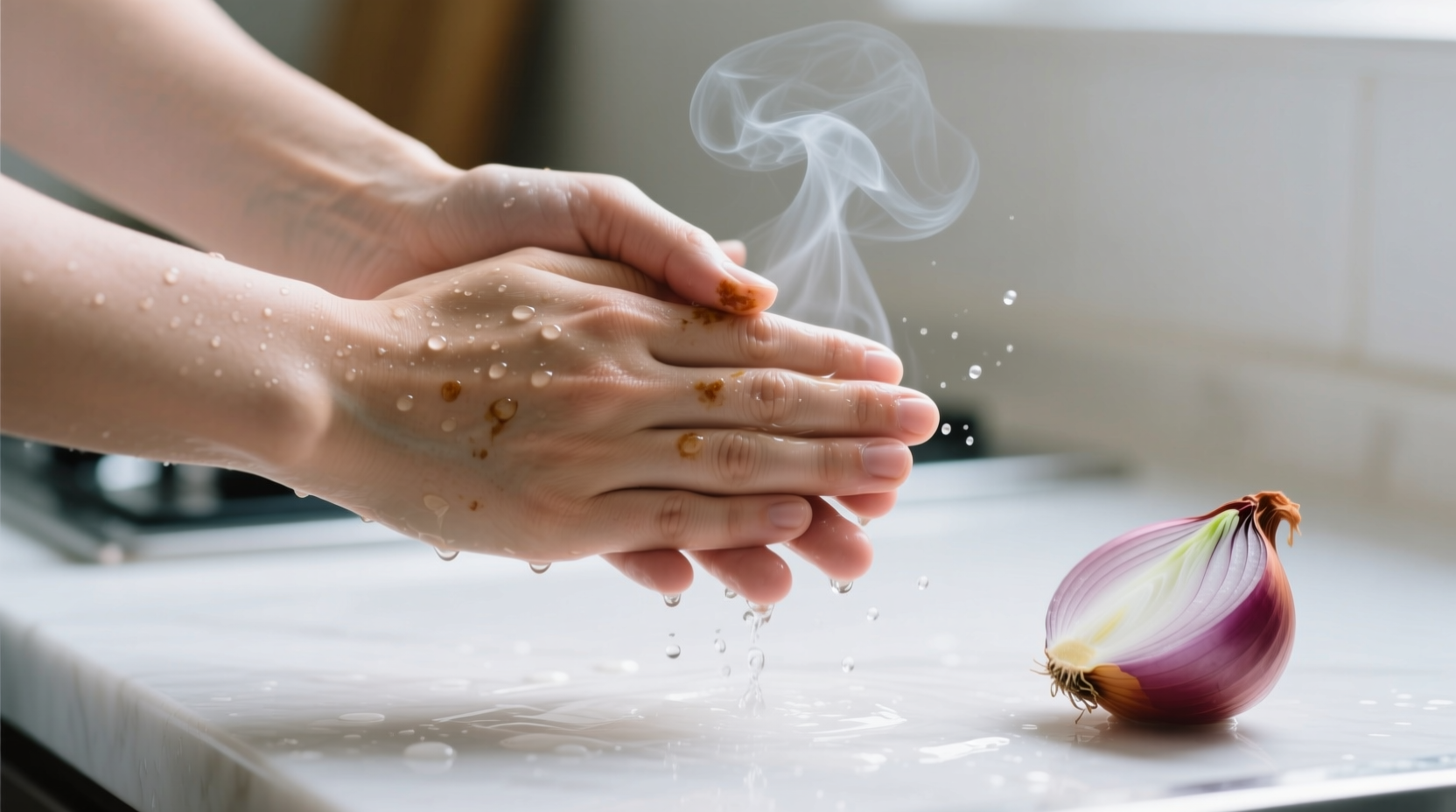Immediately eliminate stubborn onion odor from your hands by rubbing them with stainless steel under cold running water for 30 seconds, or use a mixture of baking soda and lemon juice for a natural, effective solution that breaks down sulfur compounds causing the smell.
Nothing ruins the joy of cooking quite like that persistent onion smell clinging to your hands long after you've finished chopping. Whether you're preparing dinner for family or experimenting with new recipes, this common kitchen problem can be frustrating and even interfere with your next cooking tasks. The good news is you don't need special products—just science-backed methods using items already in your kitchen.
That pungent onion odor sticks around because of sulfur compounds called thiosulfinates that transfer from the onion to your skin when you cut them. These compounds bind strongly to the proteins in your skin, making the smell particularly stubborn. Understanding this chemistry is key to choosing the most effective removal method.
Why Onion Smell Sticks to Your Hands
When you cut an onion, you break open cells containing an enzyme called alliinase that reacts with sulfur compounds to create the volatile substances responsible for both the tear-inducing effect and the lingering smell. These compounds form strong bonds with the keratin in your skin, which is why regular soap often fails to completely eliminate the odor.
| Method | Effectiveness | Time Required | Materials Needed |
|---|---|---|---|
| Stainless Steel + Water | ★★★★☆ | 30 seconds | Sink, stainless steel object |
| Baking Soda Scrub | ★★★★☆ | 1 minute | Baking soda, water |
| Lemon Juice Rinse | ★★★☆☆ | 45 seconds | Fresh lemon, water |
| Regular Soap Only | ★☆☆☆☆ | 1 minute | Hand soap |
Immediate Solutions for Onion Smell Removal
Stainless Steel Method (Most Effective)
This surprisingly effective technique leverages chemistry. The iron in stainless steel reacts with the sulfur compounds, breaking their bond with your skin proteins. Simply hold a stainless steel spoon, soap dispenser, or even your sink faucet while running cold water over your hands for 30 seconds. Rub your hands thoroughly against the metal surface, paying special attention to fingertips and cuticles where odor concentrates.
Baking Soda and Lemon Juice Combination
Create a paste with one tablespoon of baking soda and enough lemon juice to form a thick mixture. The citric acid in lemon juice neutralizes alkaline sulfur compounds while baking soda acts as a gentle abrasive. Massage this paste into your hands for 45 seconds, then rinse thoroughly with cold water. This dual-action approach works particularly well for stubborn odors after handling multiple onions.
Vinegar Rinse Technique
White vinegar's acetic acid breaks down the sulfur molecules causing the smell. Mix equal parts white vinegar and water in a small bowl. Soak your hands for 30 seconds, then wash with regular soap and water. While effective, this method may leave a temporary vinegar scent that dissipates quickly.

Advanced Techniques for Persistent Odors
Coffee Grounds Exfoliation
Used coffee grounds provide gentle exfoliation while their strong aroma masks and neutralizes onion smell. After handling onions, rub a handful of damp coffee grounds between your palms for 20 seconds before washing with soap. The coarse texture helps remove the top layer of skin where odor compounds reside.
Hydrogen Peroxide Solution
For particularly stubborn odors after extended onion preparation, mix one part 3% hydrogen peroxide with two parts water. Soak hands for 15-20 seconds, then rinse thoroughly. Hydrogen peroxide oxidizes the sulfur compounds, effectively neutralizing the smell. Important: Never use undiluted hydrogen peroxide as it can irritate skin.
Prevention Strategies for Future Cooking
Pre-Handling Preparation
Before chopping onions, rub a small amount of cooking oil on your hands. The oil creates a barrier that prevents sulfur compounds from bonding directly with your skin. Alternatively, wear thin food-safe gloves specifically designed for kitchen use—they're nearly invisible and won't interfere with your knife skills.
Onion Handling Techniques
Chefs recommend chilling onions in the refrigerator for 30 minutes before cutting. Cold temperatures slow the enzymatic reaction that creates the volatile sulfur compounds, reducing both tears and odor transfer. Use a sharp knife to minimize cell damage—dull knives crush more cells, releasing more odor-causing compounds.
What Doesn't Work (And Why)
Despite popular belief, certain common suggestions lack scientific backing:
- Soap alone: Most hand soaps don't contain ingredients that break sulfur bonds effectively
- Hot water: Actually opens skin pores, allowing deeper odor penetration
- Mouthwash: Contains alcohol that can dry skin without addressing the chemical compounds
According to food science research from the University of California, Davis, methods that work change the molecular structure of the sulfur compounds rather than just masking the odor. Their studies confirm that acid-based solutions and metal interactions provide the most reliable results for neutralizing onion smell on skin.
When to See a Professional
While onion smell is merely annoying for most people, those with sensitive skin may experience irritation from repeated exposure. If you notice persistent redness, itching, or burning after handling onions, consult a dermatologist. Some individuals develop contact dermatitis from frequent exposure to allium vegetables. The American Academy of Dermatology recommends using barrier creams if you experience recurring skin issues during food preparation.











 浙公网安备
33010002000092号
浙公网安备
33010002000092号 浙B2-20120091-4
浙B2-20120091-4